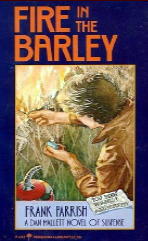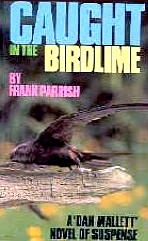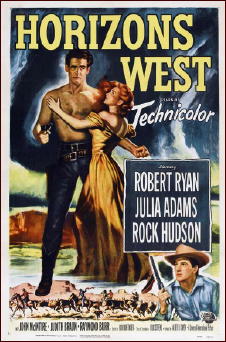July 2014
Monthly Archive
Fri 25 Jul 2014
TWENTY DETECTIVE NOVELS BY LITERARY AUTHORS — A LIST
by Josef Hoffmann
Of course Hammett, Chandler, Simenon and other crime writers are authors with a literary quality, but they are classified as mystery writers whose work is typical of the genre. The literary authors I refer to have written detective novels as an exception to their work which is considered as literature. Some of these detective novels are rather unusual and not typical of the genre, some are rather conventional.
The following list is not complete.
Auster, Paul: City of Glass, Sun & Moon 1985 (in The New York Trilogy)
– : Ghosts, Sun & Moon 1986 (in The New York Trilogy)
– (as Paul Benjamin): Squeeze Play, Alpha-Omega 1982
Butor, Michel: Passing Time, Calder 1960, Simon 1960 (Translation of L’Emploi du Temps, 1956)
Chekhov, Anton: The Shooting Party, Paul 1926 (Translation of Drama na ochote, 1884)
Doderer, Heimito von: Every Man a Murderer, Knopf 1964 (Translation of Ein Mord, den jeder begeht, 1938)
Dürrenmatt, Friedrich: The Judge and His Hangman, Jenkins 1954 (Translation of Der Richter und sein Henker, 1952)
– : The Pledge, Cape 1959 (Translation of Das Versprechen, 1958)
– : The Quarry, Cape 1962 (Translation of Der Verdacht, 1959)
Fonseca, Rubem: Bufo & Spallanzini, Dutton 1990 (Translation of Bufo & Spallanzini, 1985)
– : Vast Emotions and Imperfect Thoughts, Ecco Press 1998 (Translation of Vastas emocoes e pensamentos imperfeitos, 1988)
Gadda, Carlo Emilio: That Awful Mess on Via Merulana, Braziller 1965 (Translation of Quer pasticciaccio brutto de via Merulana, 1957)
Handke, Peter: Der Hausierer, Suhrkamp 1967 (as far as I know, not translated)
Hjortsberg, William: Falling Angel, Harcourt 1978
Kertész, Imre: Detective Story, Knopf 2008 (Translation of Detektivtörténet, 2001)
Pynchon, Thomas: Inherent Vice, Penguin Press 2009
Robbe-Grillet, Alain: The Erasers, Calder 1963 (Translation of Les Gommes, 1962)
Tabucchi, Antonio: The Missing Head of Damasceno Monteiro, New Directions 1999 (Translation of La testa perduta di Damasceno Monteiro, 1997)
Vargas Llosa, Mario: Who Killed Palomino Molero?, Farrar 1987 (Translation of Quien mato a Palomino Molero?, 1986)
– : Death in the Andes, Farrar 1996 (Translation of Lituma en los Andes, 1993)
Further Reading:
Detecting Texts. The Metaphysical Detective Story from Poe to Postmodernism, edited by Patricia Merivale, Susan Elizabeth Sweeney, PENN 1999
Fri 25 Jul 2014

THREE BLONDES IN HIS LIFE. Cinema Associates, 1961. Jock Mahoney, Greta Thyssen, Jesse White, Elaine Edwards, Anthony Dexter, Valerie Porter. Director: Leon Chooluck.
When an insurance investigator on the West Coast mysteriously disappears, the head of the firm on the East Coast sends Duke Wallace, Jock Mahoney’s character, across country to find out what happened.
Turns out that the man in question was seriously attracted to blondes, and his wife has dyed her hair that color to keep him, to little avail. It also turns out that the man is dead, in what appears to be a love nest cabin up in the mountains. There are two other blondes in the story, both love-starved wives involved in cases that Collins (the dead man) had been working and closed.
What this is is the kind of movie in which we see just how love-starved the three blondes are, as Duke makes his appointed rounds (in suit and tie) to each of the three ladies in question and in turn, but the funny thing is that he always manages to keep the suit and tie on, or at least he does while the cameras are rolling.
There also is a lot of emphasis on bosoms and bottoms, including those of the secretary of the fellow who heads up the West Coast office, but since she’s a brunette, she doesn’t really count, but I’ll mention the actress who plays her, Darlene Hendricks, just for the record.

I was reminded a lot of the second- or third-rank tier of fictional PI’s in the paperbacks of the 50s and 60s, guys like Johnny Liddell, Peter Chambers and Lou Largo. The budget was smaller than it might have been, though, and the story seems to end just as the money probably ran out.
There is one fight scene that might make this movie worth watching, though, if you happen to watch long enough. It comes quite close to end, and it begins with Duke, or rather Jock Mahoney doing his own stunts (or so I’m told), crashing headlong through a closed door, clear across the room at full tilt, and ramming into the guy inside, uptilting him as well as himself against a stuffed chair and into the wall on the left side of the screen, upon which point they manage to smash up the rest of the room very thoroughly and badly.
It nearly took my breath away, it did.
Thu 24 Jul 2014

SHERLOCK HOLMES AND THE DEADLY NECKLACE. Central Cinema Company Film, Germany, 1962. Original title: Sherlock Holmes und das Halsband des Todes. Christopher Lee (Sherlock Holmes), Thorley Walters (Dr. Watson), Hans Söhnker (Professor Moriarty), Hans Nielsen, Senta Berger, Ivan Desny, Wolfgang Lukschy, Leon Askin, Edith Schultze-Westrum (Mrs. Hudson). Screenplay: Curt Siodmak, based on the novel The Valley of Fear, by Sir Arthur Conan Doyle. (Co-)Director: Terence Fisher.
In spite of some very good scenes, this film was largely a disappointment, the first reason being that all of the English-speaking actors, including Christopher Lee, were dubbed (or redubbed) back into English, by the voices of others. What a waste of talent, and only to save a few dollars in production costs (as I understand it).

Perhaps even better than Lee in the leading role is the German actor who plays Moriarty, and very much Holmes’ equal in several tense scenes they share together. As Dr. Watson, British character actor Thorley Walters plays the part as one or two notches above the level of Nigel Bruce’s bumbling portrayal, but no more than that, nor is he nearly as charming.
There is very little resemblance to the story in this film to Doyle’s Valley of Fear, but the one scene which appears in each is one of the better ones in the film. The “Deadly Necklace” of the title is one that belonged to Queen Cleopatra of Egypt, and Dr. Moriarty is determined to have it in his possession, at all costs. Sherlock Holmes demurs, and the game is on.

The setting seems to be in the 1910s, based on the use of vintage autos of that era rather than hansom cabs, which clashes with a very nice jazzy and swinging film score much more appropriate to a jazzy and swinging movie from the 1960s.
But the biggest problem is the presence of scenes that exist only for cinematic effect and otherwise do not go anywhere, such as an opening scene with Holmes (in disguise) watching Moriarty at the docks before we know who either player is, and which is not referred to later on except in the briefest of mentions.

Or another in which Holmes (in disguise) calls for help in front of his apartment in Baker Street, is “rescued” by Watson, who finds him collapsed on the doorstep and does not recognize his friend. It is all a hoax played by Holmes on Watson, but why?
And, oh, one other thing. Whenever I leave my car, whether I’m involved in an accident or not, I always take my keys with me.
Give this one a pass, unless you’re a fan of Christopher Lee. Fans of Sherlock Holmes might otherwise want to stay away, or at least don’t go too far out of your way to obtain a copy, even though copies are easily (and quite inexpensively) found.
Thu 24 Jul 2014
Posted by Steve under
Reviews[3] Comments
IT IS PURELY MY OPINION
Reviews by L. J. Roberts
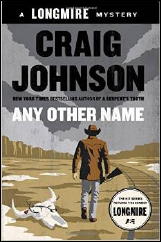
CRAIG JOHNSON – Any Other Name. Viking, hardcover, May 2014. Police procedural: Sheriff Walt Longmire, 10th in series. Setting: Wyoming.
First Sentence: Joseph Conrad said that if you wanted to know the age of the earth, look upon the sea in a storm; if you want to know the age of the Powder River country just be on the wrong side of a coal train.
Sheriff Walt Longmire is about to be a grandfather —very soon. He has promised his daughter, Cady, that he will be in Philadelphia for the baby’s birth. His old friend and former boss, Lucian Connally, asks him for a favor of going with him to an adjacent county and visit a woman whose daughter is missing. One missing woman leads to secrets, corruption and possible death.
Johnson is the epitome of a story teller. You are not a viewer; you are a participant. How does he do it? He starts by hooking you into the story from the very beginning by his strong voice and the ability to create a very visual sense of place. He makes you feel and see what he describes. His inclusion of spiritualism adds to the sense of place, the strength of the character and the story.
Part of that voice is his humor. It’s not situational, but dry and natural. His dialogue is among the best being written. Most of it is his characters. Walt is such an engaging character. He is truly the “long arm of the law†and well-liked by his colleagues. But he’s not infallible nor is he superman.
The supporting characters of Henry Standing Bear and Undersheriff Vic Moretti, Lucian and Dog are significant to the story. Best of all, even the secondary characters are well developed. None of Johnson’s characters are flat or stereotypes. They all have a part to play in the effectiveness of the story. Even the weather becomes a character within the story.
Any Other Name is an excellent book. It’s filled with tension and breath-catching suspense, but the pacing is perfect with enough pauses in the action for balance. Johnson is an author who both entertains you and educates you. There’s not a single wrong step to be found.
Rating: Excellent.
Wed 23 Jul 2014
Reviewed by DAVID VINEYARD:
CLARENCE H. NEW – The Unseen Hand: An Adventure of the Freelancers of Diplomacy. Doubleday Page & Co., hardcover, 1918. Wildside Press, softcover reprint. Illustrated by Clinton Pettee. Available in ebook form online here.
The following appeared in the January 15. 1933, issue of the New York Times:
C.H. NEW, NOVELIST, ASKED THEM IN HIS WILL NOT TO “SCATTER†HIS EFFECTS
The heirs of Clarence H. New, Brooklyn novelist, whose serial, the Freelancers of Diplomacy, ran for twenty three years in
Blue Book, are enjoined in his will from “scattering about†his personal effects in foreign countries.
The will goes on to explain his son and grandson were travelers and prone to leave items behind them, and concludes with a quote from the will:
“As I do not believe anyone regains consciousness after death,†the will says. “I wish it distinctly understood there shall be no church or funeral ceremony.â€
That explains a bit about New, but not the Freelancers of Diplomacy, whose adventures ran in Blue Book for twenty three years with out a break, a saga Robert Sampson describes in Yesterday’s Heroes as unparalleled in American pulp history.
Despite a history of adventure covering a few thousand pages and by my guesstimate at least one million words, there remains only one novel recounting the adventures of the Freelancers of Diplomacy, The Unseen Hand, what in science fiction used to be called a ‘fixup,’ a bit of new material tying together several shorter adventures from the magazine.
We are given a brief history of said Freelancers from the point of view of the Germans who have recently learned the identity of the group and its leader from an American magazine — a surprisingly modern touch considering recent events in the real world of espionage and diplomacy.
Cassells monthlies … devotes quite a lengthy article to the ‘Diplomatic Free Lance’ and his associates. This man will be remembered — by the most contemptible betrayal of confidence reposed in him by his former German hosts, who had entertained him and the woman masquerading as his wife, upon the supposition that they were people of breeding who belonged to the aristocracy — has been the solitary exception among the English to be really dangerous to us, and a rope is waiting for him as soon as he is caught. Various conjectures have been made by Wilhelmstrase as to his identity — but the truth is now kindly offered to us by the fools across the channel. It seems that he is — as we have been morally certain for sometime — a certain sports crazed English peer who has never been credited with the least political ability, Lord Trevor, of Dartmoor. In his nefarious and unprincipled schemes against us he has been assisted by the woman posing as his wife, Lady Nan Trevor; by a Sir Edward Lammerford, who was once dismissed by the English Foreign office for conduct unbecoming a diplomat and a gentleman; by a blackamoor servant calling himself an Afghan prince; by Sir Edward Wray, whose thinly veiled name is easily recognizable by every German who recalls the black treachery of August 1914; by an attache of the American Embassy in Paris; and by the old reprobate Cavaliere Scarpa, in Italy.
Giving us our introduction to the League of the Scarlet Pimpernel — oh, sorry wrong century, the Freelancers of Diplomacy.
Of course we know quite a bit more, for instance that Lord Trevor, the idle sportsman who is mastermind behind this group, is really American Cyrus K, Grisscome, alias Commander Cresspinge, who operated for President Roosevelt (Teddy) using his fast yacht as a mobile base.
Of course the resemblance is only one of those coincidences of fiction … because there are no such people as Viscount Trevor of Dartmoor or Sir Edward Wray (hint, he may be the Prime Minister) in DeBrett’s. “It’s a legend, a joke, Baron Munchausen and Sherlock Holmes combined, gossip, hearsay, pure fiction …â€
If you think this is all terribly old-fashioned and out of date I refer you to bestselling writer Ted Bell’s half-American peer Alexander Hawke, Lord Hawke, who ‘freelances’ a bit himself from his heavily armed super fast yacht the Hawke. What goes around as they say.
And it is only a coincidence that the Condessa de Montessa, her moorish servants, her titled Afghan friend, Baron W, and her husband the Earl occupy apartments so like those described in the stories published about the Diplomatic Freelance in Cassells.
In short order we are filled in on the adventures of Cyrus Grisscome and how he ‘might’ have become Viscount Trevor, and how perhaps the Diplomatic Free Lance is something like the Mission Impossible team undertaking missions that the government can deny should they fail or be captured. About the only thing missing is the theme music and the self destructive instructions.
Noticeably there is a good deal of back story to fill in for a series that runs twenty three years, but by chapter two we are off on the adventure, and chapter one has at least been intriguing. The ten chapters that follow are loosely connected adventures from Blue Book such as “The Aldershot Affair,” “Touching on the Honor of Islam,” “The Neutrality of Holland,” “A Machiavellian Coup in Roumania,” “The Mysterious Camp in the Pyrenees” … and the plot and action are almost non-stop and well told. For instance in that last one, Trevor and company have to foil a plot to invade France with sixty thousand men hidden in the Pyrenees wearing stolen American uniforms.
Fantastic? Perhaps, but in WWI the Germans actually tried to smuggle anthrax-infected mules into France through the Pyrenees and in WW II specially trained SS donned American uniforms and penetrated the American lines at the Battle of the Bulge.
Bulldog Drummond fans may appreciate a certain Madame Irma and her ‘supposed husband’ whose allegiances are in question. The Freelancers also barely avert a plot to kill Kitchener with the fleet at Skager Rock — not unlike his real death organized by the real German spy known as Fraulien Doktor. New at least knew how to read the newspapers and extrapolate.
As with Oppenheim, Le Queux, and even Buchan and Sapper, at least some of the appeal of these was the feeling of being in on the back rooms of intrigue and espionage. Eric Ambler, Ian Fleming, and John le Carre would all mine the same territory one way or another. Whenever Bell’s Lord Hawke is in conference with the President of PM and the various Secretaries and Ministers he routinely rubs noses with it is a nod to the past and the beginnings of the genre.
Treachery waits at every crossroads. Are there those in Spain who would aid the Kaiser to gain greater favor, can the Bulgarians be trusted (if you read Ian Fleming the answer is no but then the Bulgarians did most of the Soviet’s dirty work in the Cold War), will Holland’s neutrality be violated?
Are people friend or foe, agents of the Boche or agents of the Entente Cordiale, fair or fowl, operating at cross purposes or for the same goal? Who can be trusted, and who should be silenced? Spy fiction hasn’t changed a lot in the century or so since its beginnings. (*)
The Diplomatic Freelancers fall somewhere between E. Phillips Oppenheim and William LeQueux, a bit more active than the former, better written and less melodramatic than the latter. No one reading this is going to discover an early version of James Bond, the real world of Eric Ambler, or even the cut throat back alley secret wars of Peter Cheyney.
Everyone has a title, everyone is a cliche, we are never all that far from the Scarlet Pimpernel; even the relative modernity of John Buchan, Sapper, Dornford Yates and the Clubland Heroes is some time ahead.
But these adventures were written with conviction. As late as the pre-war years Max Brand’s Anthony Hamilton spy stories were still on this mode with spies in white tails and slinky women in black velvet, as, in many ways, were the adventures of Operator #5, and even the more realistic adventures of John P. Marquand’s Mr. Moto. And not unlike the heroes those, British agent he may be, Cyrus Grisscome is still an American and knows his own countries neutrality won’t stand against German aggression.
“There are still a few of the old breed living in America, your Highness — And they’ll wipe the stains from our good old flag in a way that will mean annihilation to everything that Germany stands for, today!â€
Duck, you Huns, Uncle Sam wants you! And admit it, even today it’s effective.
Like Somerset Maugham’s Ashenden, or the British Agent — which it resembles in no other way — it ends with the Russian Revolution and hints of a new secret war to come in which the Diplomatic Freelancers will be needed once again. Already in 1918 the writing on the wall was clear, and this time in bright red.
These tales and the twenty-three years worth of saga from Blue Book are worth reading today for more than nostalgia. We may be as much in Ruritania or Graustark as the real Europe, and there may be a few deadly electronic eyes (even Oppenheim used that one in The Wrath to Come), exploding cigars and poisoned needles (Le Queux’s Duckworth Drew), femme fatales poured into elegant black satin and opera gloves (everyone save Buchan), untrustworthy ‘fureigners’, loyal Afghan princes and moorish servants, and all the trappings of an earlier age, but the writing is good, the stories are fun, and the musty scent of crumbling pulp paper intoxicating, even in electronic form.
If Clarence New and the Diplomatic Freelancers are only a name faintly redolent of black velvet cloaks lined in red satin and crossed daggers, or even if they are completely unknown to you, they are worth the effort to become acquainted with.
There are touches of modernity, good old fashioned swashbuckling, intrigue, adventure, and entertainment to be had, and the dust you have to blow away to get to it is nowhere near as deep as you might expect. Blue Book was one of the Cadillacs of the pulps, in a rank with Adventure, Top Notch, and the various incarnations of Argosy. Names like John Buchan and Agatha Christie graced Blue Book‘s pages, so New is in heady company.
You won’t have to lower your standards to enjoy this book, and you may wish you knew someone with a complete collection of Blue Book so you could read more. That’s a high recommendation for any series out of the pulps, though managing twenty three years of consecutive issues may be a bit ambitious for most collectors. From this example it might well be worth the effort though aside from the countless other examples of well written fiction gracing those pages.
(*) The first modern spy novel, by all critical opinion, is John Buchan’s The Power House from 1910, however Le Queux, Oppenheim, Fred White, the adventures of Norroy and others at least reach back to the late 1880‘s early 1890‘s into the turn of the century, and it could be argued as far back as the Trojan Horse and the two Israelite spies who enter Jericho.
Sherlock Holmes and Martin Hewitt render services to England in the area of espionage and counter-espionage, and Sexton Blake was always encountering foreign agents. Certainly the doings at Zenda in Ruritania are secret service work, and as far back as Stevenson’s ‘Pavillion on the Links’ there is international skullduggery taking place in placid old England.
For that matter Dumas Musketeers and Monte Cristo are the very definition of ‘cloak and dagger.’ The spies may change from the Tsar’s Secret Police to the lads at Wilhelmstrasse, to Reds under the covers, and back to the Gestapo, the Japanese, the Soviets, the Chinese, Islamic terrorists, all the way to Putin’s Russia to day, but the odds and the heroes are remarkably consistent interspersed of course with an overlay of Carl Petersons, Fu Manchus, and Blofields when ever international politics got a bit dull.
Wed 23 Jul 2014
THE ARMCHAIR REVIEWER
Allen J. Hubin
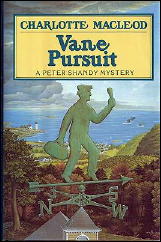
CHARLOTTE MacLEOD – Vane Pursuit. Mysterious Press, hardcover, 1989; paperback, 1990.
Vane Pursuit is one of the better tales in Charlotte MacLeod’s series about Peter Shandy, professor of botany at Balaclava College in the nether regions of Massachusetts. Shandy’s wife Helen is here working on a book project involving the potentially famous weathervanes created by the nomenclaturally unforgettable Praxiteles Lumpkin.
However, disaster seems to attend her photographic rounds: buildings burn and weathervanes are destroyed. Or mysteriously disappear. One of the casualties is the Lumpkin Soap Factory, the conflagration of which destroys the Lumpkinton employment base, returns one employee to his Maker, and signals the departure of a particularly stellar vane.
These goings-on, plus the antics of a crew of rural survivalists and a fascinating cave dweller, fully engage the Shandys to the brinks of their lives. Vane Pursuit has a stronger plot than some in this series, with less reliance on the soon tiresome tactic of outrageous character names, and the dialog is sprightly.
— Reprinted from The MYSTERY FANcier,
Vol. 11, No. 3, Summer 1989.
The Professor Peter Shandy series —
Rest You Merry (1978)
The Luck Runs Out (1979)
Wrack and Rune (1981)
Something the Cat Dragged in (1983)
The Curse of the Giant Hogweed (1985)
The Corpse in Oozak’s Pond (1986)
Vane Pursuit (1989)
An Owl Too Many (1991)
Something in the Water (1994)
Exit the Milkman (1996)
Tue 22 Jul 2014
Reviewed by JONATHAN LEWIS:
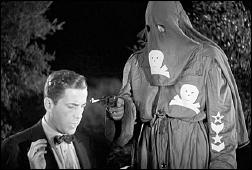
BLACK LEGION. Warner Bros., 1937. Humphrey Bogart, Dick Foran, Erin O’Brien-Moore, Ann Sheridan, Helen Flint, Joe Sawyer. Director: Archie Mayo.
Black Legion is a 1937 crime drama/proto-film noir directed by Archie Mayo and starring Humphrey Bogart. The movie is both a good suspense tale and a morality play, an attempt to categorize anti-immigrant vigilantism as distinctly anti-American. Overall, it’s a very good film, rich on atmospherics and with excellent acting by Bogart. Still, it comes across as just a bit too predictable, replete with a lumbering, albeit well-intentioned, political sermon at the very end.
The plot follows factory worker and dedicated family man Frank Taylor (Bogart) as he spirals ever downward into a self-destructive morass of alcoholism, rage, and political violence.
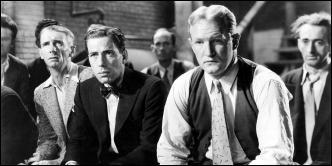
After being passed over for a promotion, with the position going instead to a man of Polish heritage, an aggrieved Taylor joins the Black Legion, a Midwest offshoot of the virulently racist Ku Klux Klan. (As an historical aside, it’s interesting to note that the studio considered, but ultimately rejected, the Romanian-Jewish born Edward G. Robinson to portray Taylor).
For a time at least, Taylor (Bogart) ends up believing the nativist slop served up on the airwaves by the Black Legion. This shortsightedness will be his downfall. His political activities will end up costing him his marriage to his wife, Ruth, (Erin O’Brien Moore) and his friendship with neighbor and work colleague, Ed Jackson (Dick Foran). Ann Sheridan portrays Jackson’s girlfriend, Betty Grogan.
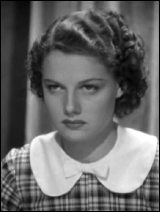
Along for the ride is Joe Sawyer, portraying the oafish, brute Cliff Summers, a factory worker who introduces him to the Legion and their nefarious activities. While it is Cliff who is responsible for getting Taylor to attend a secret, subterranean Black Legion meeting, it is ultimately Taylor and Taylor alone who is responsible for nearly everything bad that happens next.
Similar to how the KKK is portrayed in the excellent film, Storm Warning, also a Warner Brothers film which I reviewed here, Black Legion portrays the organization as much as a scam as a nativist organization. The film goes to great lengths to show the audience that the Black Legion’s leadership consists of con men primarily interested in money and profits. They’re selling nativism and a bunch of gullible fools are buying.
Black Legion isn’t remotely a happy film. Indeed, there is something very noir about both the film and its protagonist. You don’t exactly feel sorry for Taylor at the end when he’s being carted off to prison for his role in the shockingly unnecessary death of his friend, Ed (Foran), who had threatened to expose the Legion’s activities to law enforcement.
All told, Black Legion remains a very good movie, one that has a powerful, if clumsily delivered message. Unlike many other Bogart films which more than stand the test of time, it just comes across as somewhat dated.
Tue 22 Jul 2014
IT’S ABOUT CRIME
by Marv Lachman
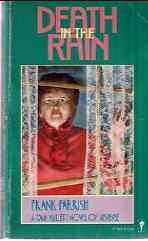
FRANK PARRISH – Death in the Rain. Dodd Mead, hardcover, 1984. Perennial Library, paperback, 1986. First published in the UK as Face at the Window (Constable, hardcover, 1984).
Fans of Dick Francis will enjoy that other master of the narrative, Frank Parrish, whose fifth book about Dan Mallett, Death in the Rain, is in paperback from Perennial Library. We identify with Francis’s heroes and feel every bit of pain inflicted by sadistic villains. With Parrish’s “professional” poacher, we observe nature as if we are also lying on the English ground, feeling the cold and dampness. He is marvelously knowledgeable about the Wessex countryside made famous by Thomas Hardy.
Death in the Rain plays down the major weakness in prior Mallett books, his long-standing attempt to get money for the hip operation his mother won’t consider free, under British socialized medicine. Yet Mrs. Mallett plays a greater role in this book, and she is a delightful supporting character.
She and Natasha Chapman, a very believable young actress, help compensate for a plot with some structural weaknesses. There are too many coincidences, too many blackmailers, and too many people simultaneously in (or watching) the murder flat.
Those are the only flaws I can discuss without giving away too much plot, but suffice it to say that, warts and all, this is as much fun to read as Parrish’s prior novels about one of the more unusual series characters of the 1980s. The first four Mallett books are also available from Perennial and equally recommended.
— Reprinted from The MYSTERY FANcier, Vol. 11, No. 3, Summer 1989.
Bibliographic Notes: Frank Parrish was the pen name of Roger Longrigg. (1929-2000). Under his own name he has two marginal entries in Hubin. Other pseudonyms are: Laura Black (four novels), Ivor Drummond (nine adventures of Jennifer Norrington, Alessandro di Ganzarello & Coleridge Tucker III) and Domini Taylor (nine novels).
The Dan Mallett series —
Fire in the Barley. Constable, 1977.
Sting of the Honeybee. Constable, 1978.
Snare in the Dark. Constable, 1982.
Bait on the Hook. Constable, 1983.
Face at the Window. Constable, 1984. US: Death in the Rain.
Fly in the Cobweb. Constable, 1986.
Caught in the Birdlime. Constable, 1987. US: Caught in the Net.
Voices from the Dark. Constable, 1993. No US edition.
Mon 21 Jul 2014
Reviewed by JONATHAN LEWIS:
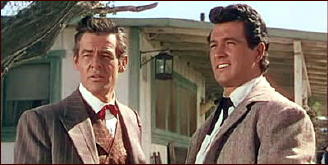
HORIZONS WEST. Universal International, 1952. Robert Ryan, Julie Adams, Rock Hudson, Judith Braun, John McIntire, Raymond Burr, James Arness, Dennis Weaver, Frances Bavier, Tom Powers. Director: Budd Boetticher.
Horizons West is a very good, albeit uneven, 1952 Universal Studios production directed by Budd Boetticher. Set in and around Austin, Texas, after the Civil War and during Reconstruction, this Western tragedy stars Robert Ryan and Rock Hudson as the brothers, Dan and Neil Hammond.
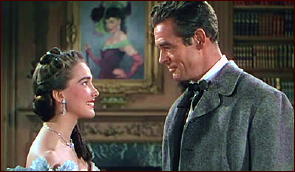
As the film progresses, Dan (Ryan) and Neil (Hudson) find themselves on opposite sides of the law, with the latter tasked with bringing in his criminal older brother back to town for trial, culminating in a final interfamilial showdown in a small Mexican town. Dan starts off as a seemingly good guy, but by the end, the man’s done gone bad, irredeemably so.
The movie benefits from its strong coterie of extremely talented actors. Aside from Ryan and Hudson, the film also stars Raymond Burr, who brilliantly portrays Cole Hardin, a sleazily villainous gambler. There’s something about Burr’s character that’s so devious that one wishes that he weren’t killed off so abruptly.
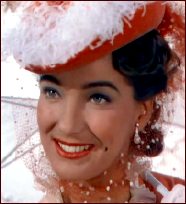
And then there’s the lovely Julia Adams (Creature of the Black Lagoon), who portrays Hardin’s wife. She inevitably falls in love with the increasingly arrogant and power-mad Dan Hammond, causing friction between Dan and Cole. Veteran character actor John McIntire portrays the stoic Ira Hammond, owner of the family ranch who watches with alarm as his son, Dan (Ryan) returns home from the war a defeated, but proud Confederate officer, only to morph into to a ruthless and corrupt Texas power player.
Aside from the skillful acting, Horizons West makes excellent use of vivid and symbolic use of colors (Technicolor works extraordinarily well here) and numerous well-constructed lush interiors. Look for the scene in front of an Austin hotel when Dan Hammond is wearing a red tie and Mrs. Hardin is wearing also wearing red in her attire. It just works perfectly.
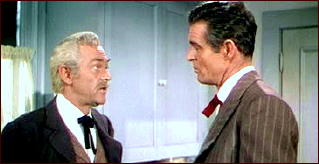
In many ways, the plot is standard, almost cliché Western fare, replete with a soldiers returning home from the Civil War, a good guy gone bad, brothers in conflict, a corrupt and flamboyant Mexican general, cattle rustling, and a lynch mob.
One can, however, view Horizons West less as a standard Western, and more as a quasi-Greek tragedy set in the American West, similar to Saddle The Wind, which I reviewed here.
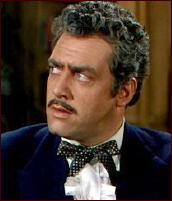
Similarly, one can interpret it as contemporaneous social criticism about how big money can corrupt otherwise good men. Indeed, by the time that the movie ends, the two overtly greedy lead characters, Dan Hammond (Ryan) and Cole Hardin (Burr), have both been killed by gunfire.
In contrast, in the final moments, the film’s most humble and hardworking characters are prospering in the bounty of the westward movement of people and cattle, hence the seemingly optimistic title of the film. But to the extent that Horizons West is about the rise and tragic fall of Dan Hammond, the film’s French title, Le Traitre du Texas (The Texas Traitor), is more accurate in conveying the film’s classically tragic overtones.
The film’s greatest flaw is in the fact that we never really get a full sense of what drives Dan Hammond to self-destruction, why he goes power mad. There’s almost no indication that something terrible happened during the war that explains his descent into villainy.
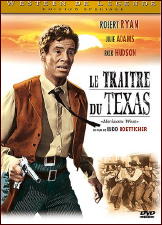
There are, however, a couple of brief moments that may shed at least some light on the matter. Soon after Dan returns home from the war with his adopted brother, Neil (Hudson) and their family’s ranch hand, Tiny McGilligan (James Arness), he tells his parents that he finds Texas to be too quiet and refers to all the noise he heard during the Civil War.
But that’s about the last he mentions of this. We never see Dan struggle with his wartime experiences, nor do we ever hear him explain to another character what drives him to cheat and to steal. The other instance is when Dan discusses finances with Ira, his father who still hasn’t paid off the debt on the ranch, something that Dan Hammond seems to find embarrassing. But again, it’s a brief exchange and one that isn’t much referred to later on.
Still, Horizons West remains a better than average Western. Ryan, Hudson, and Burr are all great actors and it shows. The film’s strongest point is its extraordinary use of color. There are many scenes in which color, rather than dialogue, is the focal point. It’s a movie that explores one man’s descent into greed and violence, but nonetheless remains truly beautiful to behold.
Sun 20 Jul 2014
THE BACKWARD REVIEWER
William F. Deeck
FRANCIS ALLAN – First Come, First Kill. Reynal & Hitchcock, hardcover, 1945 Bantam #34, 1946.

In the midst of her honeymoon, Linda Gordon (née Payne) has to return to New York City because her father had, most unlike him — he’d never done it before, you see — committed suicide. Or so it would seem.
Luckily, Mr. Payne had previously called in John Storm, private detective, to investigate an attempt at extortion by a singularly strange woman. Storm concludes Payne was murdered, a crime committed by a cool and devious person for gain, and Linda might be next.
Besides Linda, four men inherit under Payne’s will. Since only one of them is both cool and devious, he must be the murderer. He should have been easy to spot also because he had had to carry a body that had been buried for two weeks without benefit of mortician. Bound to leave its mark, one would think, but this does not occur to Storm.
Allan’s characters do a lot of gasping, occasionally half gasping. Curiously, the asthmatic doesn’t; instead, he sneezes. They also do a significant amount of communicating with their eyes, which are hot, or sick and vacant, or ex-pressing animal fury, or half angry, though which half is not made clear.
A strange choice for Bantam to reprint early in its history.
— Reprinted from The MYSTERY FANcier, Vol. 11, No. 3, Summer 1989.
Bibliographic Notes: Francis K. Allan (1916-1997) was a prolific writer for the detective pulps. Allan was also the author of two other hardcover novels: The Invisible Bridge (Reynal, 1947) and Death in Gentle Grove (Mason/Charter, 1976).
« Previous Page — Next Page »






